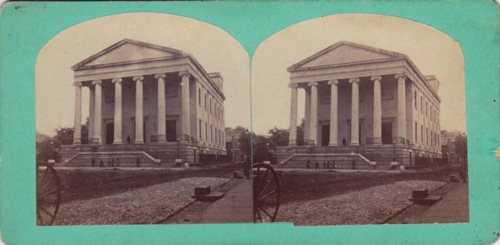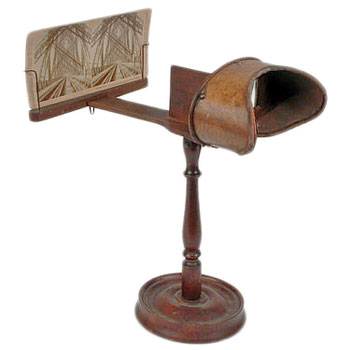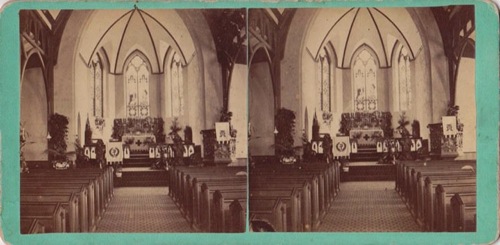|

 |
|
 Hallo
again to all. Hallo
again to all.
In one of the deep drawers of our desk you will find a shoebox or three full of stereoviews. Once on the forward edge of photography, stereoviews use two images in careful arrangement to preserve the three-dimensional view that is lost in an ordinary photograph. Some have vivid reds, greens, blues, and yellows—usually faded only a little from the century and more they have lived in shoeboxes like our own between periodic visits to the outside world. Most, though, are in sepia or grey tones: still, captured, depth-charged moments from the past. We've never known anyone whose face failed to light up with delight when holding a stereoscope for the first time, seeing two images come into crisp focus as one, and catching a glimpse of ancient sunlight shining through the windows.
Perhaps not unsurprisingly, one of the stereoview subjects we most enjoy collecting is the large sub-genre of church interiors or views with generally ecclesiastical themes.* They offer a snapshot with a twist, often of a moment in a church's architecture or internal arrangement that has not made its way onto websites or into history books. And like so much in church history and church life today, they are all about perspective.
 It occurred to us this week as we took a church-crawl by stereoview through the 1870s and 1880s that it is possible to look at one side of a view and think one has the whole picture. One can likewise look at a stereoview without benefit of a stereoscope and think that there are two nearly-identical images of the same place. Neither approach allows us to see the rich approximation of reality that the view is intended to convey. Both leave the unprepared or unthinking looker with an impression of flat two-dimensionality or an assumption of accuracy where there is none. This unaided split view will always be a false view. It occurred to us this week as we took a church-crawl by stereoview through the 1870s and 1880s that it is possible to look at one side of a view and think one has the whole picture. One can likewise look at a stereoview without benefit of a stereoscope and think that there are two nearly-identical images of the same place. Neither approach allows us to see the rich approximation of reality that the view is intended to convey. Both leave the unprepared or unthinking looker with an impression of flat two-dimensionality or an assumption of accuracy where there is none. This unaided split view will always be a false view.
Bear with us for a moment while we tie this into the modern Anglican world, a place where the split view and its false perspective is becoming more and more common. We've encountered an incorrectly two-dimensional model over and over in recent years, generally in connection with the assumption that the words Anglican and Episcopal are somehow opposed instead of complementary, local variations. We've told some interlocutors that we're Anglicans and been understood as saying that we're not Episcopalians (or not Americans). With other conversation partners, the situation is reversed: they understand people who identify themselves as Episcopalians to be saying that they are not Anglicans. We throw our hands up in frustration, and hope you do, too.
We know that you know small-e episcopalian to mean a church body is governed by bishops. And we know that you know Anglican, as an adjective, has to do with historical derivation from England. Both of these thing are true in every place where Anglicans call themselves Episcopalians, or Episcopalians call themselves Anglicans. Somewhere, someone decided somewhen that he would use these words differently, but we're not falling in lockstep behind.**
 The words Anglican and Episcopal are halves of an ecclesiastical stereoview. Split them apart by schism or trademark and you have a half-truth. It may be a basically attractive half-truth—after all, it's still half true—but it is not the richness or clarity that can be provided by a more informed approach to the matter. Episcopalians are Anglicans are Episcopalians, and anyone who tells you otherwise is playing fast and loose with history, language, tradition, reason, and perhaps even your pocketbook. The words Anglican and Episcopal are halves of an ecclesiastical stereoview. Split them apart by schism or trademark and you have a half-truth. It may be a basically attractive half-truth—after all, it's still half true—but it is not the richness or clarity that can be provided by a more informed approach to the matter. Episcopalians are Anglicans are Episcopalians, and anyone who tells you otherwise is playing fast and loose with history, language, tradition, reason, and perhaps even your pocketbook.
Of course this is all a logomachy, but for all that it's not unimportant. Words and names
shape minds. And minds, when they're informed well, can also shape hearts as well. We need
the spiritual equivalent of a stereoscope to fix our focus and right our perspective, and
Lent is as good a time as any to set these things aright. Fight the trend to oppose Anglican
to Episcopal or vice versa, and to oppose either to Christian. Once we have the decks cleared
of the débris of misapplied names, we can get about the business of being the church for
the healing of the world and the good of its people.
See you next week.

All of us at Anglicans Online
|

